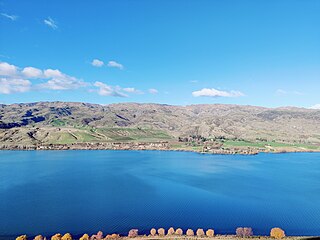
The Anatidae are the biological family of water birds that includes ducks, geese, and swans. The family has a cosmopolitan distribution, occurring on all the world's continents except Antarctica. These birds are adapted for swimming, floating on the water surface, and, in some cases, diving in at least shallow water. The family contains around 174 species in 43 genera.

The Oxyurini are a tribe of the duck subfamily of birds, the Anatinae. It has been subject of considerable debate about its validity and circumscription. Some taxonomic authorities place the group in its own subfamily, the Oxyurinae. Most of its members have long, stiff tail feathers which are erected when the bird is at rest, and relatively large, swollen bills. Though their relationships are still enigmatic, they appear to be closer to swans and true geese than to the typical ducks. The highest diversity is found in the warmer parts of the Americas, but at least one species occurs in a major part of the world.

The Clutha River is the second longest river in New Zealand and the longest in the South Island. It flows south-southeast 338 kilometres (210 mi) through Central and South Otago from Lake Wānaka in the Southern Alps to the Pacific Ocean, 75 kilometres (47 mi) south west of Dunedin. Gold is in abundance in the Clutha River and its surrounding areas. It is the highest volume river in New Zealand, and has a discharging mean flow of 614 cubic metres per second (21,700 cu ft/s).

Metrosideros is a genus of approximately 60 trees, shrubs, and vines in the family Myrtaceae, mostly found in the Pacific region. Most of the tree forms are small, but some are exceptionally large, the New Zealand species in particular. The name derives from the Ancient Greek metra or "heartwood" and sideron or "iron". Perhaps the best-known species are the pōhutukawa, northern rātā and southern rātā of New Zealand, and ʻōhiʻa lehua from the Hawaiian Islands.

The Manuherikia River is located in Otago in the South Island of New Zealand. It rises in the far north of the Maniototo, with the West Branch draining the eastern side of the St Bathans Range, and the East Branch draining the western flanks of the Hawkdun Range. The river continues southwest through the wide Manuherikia Valley to its confluence with the Clutha River at Alexandra. During the 1860s the Manuherikia was one of the centres of the Otago gold rush.

St Bathans, formerly named Dunstan Creek, is a former gold and coal mining town in Central Otago, New Zealand. The settlement was a centre of the Otago gold rush, but mining has since long ceased. It is now largely a holiday retreat due to the preservation of many of its historic buildings.

Omakau is a settlement in Central Otago, New Zealand, located between Alexandra and Ranfurly on the northwest bank of the Manuherikia River. The smaller settlement of Ophir is located on the opposite bank, three kilometres to the southeast.
Waipiata is an historic place on the Otago Central Rail Trail, in Central Otago, New Zealand. Waipiata is also the name of many New Zealand coastal vessels, steamers, freighters and steamships.

Collocalia is a genus of swifts, containing some of the smaller species termed "swiftlets". Formerly a catch-all genus for these, a number of its former members are now normally placed in Aerodramus.

Ophir is a small settlement in Central Otago, New Zealand, located between Alexandra and Ranfurly close to the east bank of the Manuherikia River. The settlement of Omakau is located on the opposite bank, 3 kilometres (1.9 mi) to the northwest.
Pelecanoides miokuaka is an extinct species of diving petrel of New Zealand. Described in 2007, it is known only from a single humerus bone that was discovered from early Miocene sediments of the Manuherikia Group.
Rupephaps taketake, also referred to as the Saint Bathans pigeon, is an extinct species of pigeon from the Miocene of New Zealand. It is the first species of columbid to be described from pre-Pliocene fossil deposits in the Australasian region.

The St Bathans fauna is found in the lower Bannockburn Formation of the Manuherikia Group of Central Otago, in the South Island of New Zealand. It comprises a suite of fossilised prehistoric animals from the late Early Miocene (Altonian) period, with an age range of 19–16 million years ago.
Manuherikia is a genus of extinct species of ducks from the Miocene of New Zealand. It was described from fossil material of the Saint Bathans Fauna, in the lower Bannockburn Formation of the Manuherikia Group, found by the Manuherikia River in the Central Otago region of the South Island. The genus name comes from the name of the geological formation in which the fossils were found and, ultimately, from the Manuherikia River and its valley.
Miotadorna is a genus of extinct tadornine ducks from the Miocene of New Zealand. It contains two species, M. sanctibathansi, and M. catrionae.
Dunstanetta johnstoneorum is a genus and species of extinct duck from the Miocene of New Zealand. It was described from fossil material collected from a Saint Bathans Fauna site on Home Hills Station, in the lower Bannockburn Formation of the Manuherikia Group, in the Manuherikia River valley in the Central Otago region of the South Island. The genus name refers to the Dunstan Range, the mountains of which overlook the fossil site. The specific epithet honours Ann and Euan Johnstone of Home Hills Station.

Pikaihao bartlei, also referred to as Bartle's bittern or the Saint Bathans bittern, is a genus and species of prehistoric small bittern from the Early Miocene of New Zealand. It was described in 2013 from fossil material found in the Saint Bathans Fauna of the Bannockburn Formation, at Home Hills Station in the Manuherikia River valley of Otago, South Island. It was a contemporary of the much larger Saint Bathans heron, remains of which have been found in the same sediments. The genus name Pikaihao comes from the Māori pi and kaihao (“fisherman”). The specific epithet honours Sandy Bartle, Curator of Birds at the Museum of New Zealand Te Papa Tongarewa from 1976 to 2009.

The Manuherikia Group is a fluvial-lacustrine sedimentary fill in the Central Otago area of New Zealand, at the site of the prehistoric Lake Manuherikia. The area consists of a valley and ridge topography, with a series of schist-greywacke mountains at roughly ninety degrees to each other. The Manuherika Group occurs in the current basins, and occasionally on the mountains themselves.
Lake Manuherikia was a prehistoric lake which once stretched over some 5,600 square kilometres (2,200 sq mi) in what is now inland Otago in New Zealand's South Island. It stretched from Bannockburn and the Nevis valley in the west to Naseby in the east, and from the Waitaki valley in the north to Ranfurly in the south, including much of the area now referred to as the Maniototo. The lake existed from around 19 to 16 million years ago during the Miocene epoch, at which point New Zealand was significantly warmer than the present.

The Dunstan Mountains are a mountain range in Central Otago, in the South Island of New Zealand. The mountains lie on the eastern shore of the man-made Lake Dunstan and overlook the towns of Cromwell to the west, Clyde to the south and Omakau to the east. The highest named peak on the mountain range, a rocky knoll simply called Dunstan, is 1,667 m.














